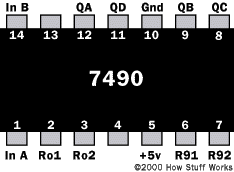7490 Pinout
Let's look at the 7490 briefly to see how it works.
The 7490 is a decade counter, meaning it is able to count from 0 to 9 cyclically, and that is its natural mode. That is, QA, QB, QC and QD are 4 bits in a binary number, and these pins cycle through 0 to 9, like this:
Advertisement
QD QC QB QA 0 0 0 0 0 0 0 1 0 0 1 0 0 0 1 1 0 1 0 0 0 1 0 1 0 1 1 0 0 1 1 1 1 0 0 0 1 0 0 1

You can also set the chip up to count up to other maximum numbers and then return to zero. You "set it up" by changing the wiring of the R01, R02, R91 and R92 lines. If both R01 and R02 are 1 (5 volts) and either R91 or R92 are 0 (ground), then the chip will reset QA, QB, QC and QD to 0. If both R91 and R92 are 1 (5 volts), then the count on QA, QB, QC and QD goes to 1001 (5). So:
- To create a divide-by-10 counter, you first connect pin 5 to +5 volts and pin 10 to ground to power the chip. Then you connect pin 12 to pin 1 and ground pins 2, 3, 6, and 7. You run the input clock signal (from the timebase or a previous counter) in on pin 14. The output appears on QA, QB, QC and QD. Use the output on pin 11 to connect to the next stage.
- To create a divide-by-6 counter, you first connect pin 5 to +5 volts and pin 10 to ground to power the chip. Then you connect pin 12 to pin 1 and ground pins 6 and 7. Connect pin 2 to pin 9 and pin 3 to pin 8. Run the input clock signal (from the timebase or a previous counter) in on pin 14. The output appears on QA, QB and QC. Use pin 8 to connect to the next stage.